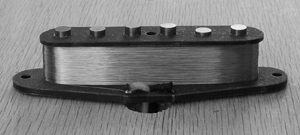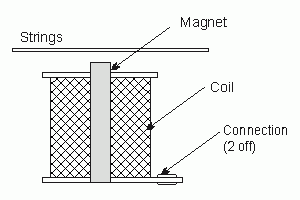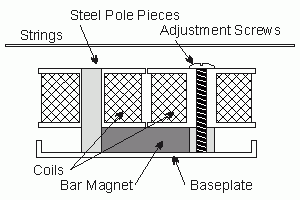Electric Guitar Pickups
 There are two kinds of pickup used on electric guitars. These are known as the ‘single coil’ and the ‘humbucker’. Each provides a discernible difference in tone for the guitar. Typically, the single coil varieties are fitted to Fender guitars such as the Stratocaster and Telecaster, and the humbucker generally fitted on Gibson guitars. Both makers offer a range of guitars that will have alternative configurations to this generalisation. With a little knowledge of pickups, and a discerning ear, you will be able to make decisions about the choice of pickups on your guitar. The pickups fitted to a guitar can be removed and altered. It is not a difficult task, though it would require some experience of soldering and the appropriate tools – so perhaps best left to someone who knows what they are doing.
There are two kinds of pickup used on electric guitars. These are known as the ‘single coil’ and the ‘humbucker’. Each provides a discernible difference in tone for the guitar. Typically, the single coil varieties are fitted to Fender guitars such as the Stratocaster and Telecaster, and the humbucker generally fitted on Gibson guitars. Both makers offer a range of guitars that will have alternative configurations to this generalisation. With a little knowledge of pickups, and a discerning ear, you will be able to make decisions about the choice of pickups on your guitar. The pickups fitted to a guitar can be removed and altered. It is not a difficult task, though it would require some experience of soldering and the appropriate tools – so perhaps best left to someone who knows what they are doing.
Pickups: Tone
Writing about tone is difficult – it is best heard, but I will have a go at describing the difference in tone between the single coil and humbucker varieites of pickup.
The single coil has a thinner, lighter sound than a humbucker. It’s rendition of tone across the range from treble, middle to bass will be clear and the frequencies at the top end, the high notes, notably present. The humbucker generally delivers a thicker, stronger tone, normally with less treble discernible in the higher notes. This is because the construction of the humbucker has a natural tendancy to cancel out these frequencies a little. If you listen to the guitar played by Robert Cray, for example, you will hear a characteristic tone delivered by single coil pickups on a Stratocaster guitar. Compare this with the tones delivered by a Gibson 335 guitar played, for example, by Larry Carlton and using humbuckers. The Les Paul ‘Gold Top’ as played by Peter Green of ‘Fleetwood Mac’ would be an example in which a Gibson model is ftited with single coil pickups – the PAF 90s. I recommend you listen to a variety of players to establish an ear for pickups and their tonal possibilities.
There is a lot of myth created around pickups. The pickup is not, by itself, a tone maker for the guitar. Essentially, a pickup will generate a current created from the vibrating strings above. How the pickup is constructed will govern the amount of current. This current is small and requires an amplifier to increase it and ultimately drive a loudspeaker. The interaction between the pickup current and the amplifier will have a notable affect upon tone. By increasing current from the guitar you may hear an increase in brighter and more mid range tones for example, while reducing guitar volume, and therefore current, you may notice more bass tones and a ‘warmer’ sound occurring. So raising and lowering guitar output current is a source of tone control. This effect works in conjunction with electronic components called capacitors used in the circuitry of the guitar. They will influence the tone you hear from the pickups. Without the capacitors, the pickups would emphasise a greater amount of high frequency tones. It is these capacitors, chosen selectively with regard to a volume control’s resistance to current, that will significantly affect tone by removing an excess of high frequencies. A lower capacitor value such as .022µF has a higher frequency cut-off. Conversely, a higher cap value such as .047µF has a lower frequency cut-off. So, a 0.047µF cap would pass more treble to ground than a .022µF cap. Simply put, the higher the capacitor value, the darker the bass tone sound. Capacitor values used for tone controls typically range from .01µF to .1µF with the more common values being .022µF, .033µF, and .047µF. Claims are often stated that even the different versions of construction of capacitor design make a further difference to tone. Given the amount of variables that arise when listening to the sound of an electric guitar, from pickup to speaker within a cabinet, the construction of the guitar and the room or space where you are listening, assessing these and other tonal claims can be very difficult. A lot of ‘tail chasing’ can occur when searching for tone and a lot will be promoted about one type of pickup over another. Knowing about pickups and what they can really do to within the configuration of guitar electronics and amplification may help when considering guitar choices. Ultimately you have to let your ears guide you.
The amplification of the guitar and how it is used, will also add some colouration to the tone you hear. Guitarists tend to work with either a ‘clean’ tone, the aim of which is to provide undistorted notes and a faithful rendition of the instrument, or a ‘dirty’ tone which is when the amp (or an effects box) is set to clip the tones to a varying degree of distortion. Although the amplifier and a variety of effects can be applied, you may still recognise the tones that are emanating from either single coil or humbucker pickups.
Pickups: Alnico and Ceramic Magnets
A pickup uses a magnet around which is a coil of very fine enameled copper wire. When the string vibrates in the field of the magnet, an electric current is produced and it this that is sent to the amplifier. One of two types of magnets will be used in an electric guitar pickup. Alnico is one and ceramic is another. Alnico magnets are made made by mixing aluminium, nickel and cobalt with iron. They are traditionally used in “Classic” and “Vintage” pickups, giving a mellow tone , smooth response and a moderate output. Their magnetic strength can decline over time.
Ceramic or Ferrite magnets are cheaper to make than alinico ones and used on lower cost instruments. They are made using a mix of Strontium and iron and have a lower magnetic strength than alinco pickups. The tone from a ceramic pickup can be noticeably brighter with more treble presence than an alnico pickup.
Pickups: Wire
A pickup’s characteristics in tone or output strength will also be affected in tone by the the thickness of the wire and the number of turns around the magnet. Some pickups, among them the more expensive ones, will have ‘hand-wound’ coils while most are machine wound. The original guitar pickups of the 50s were hand wound from which discussion follows that these coils, with their less consistent or regular winding than a machine turned pickup, leads to a characteristic and discernible difference between a ‘vintage’ pickup and a modern one. I will leave it for you to set up the test one day maybe and decide. Pickup makers can select different gauges of wire and alter the number of turns of the coil to adjust both its tonal response and strength of output. This is useful for example if your guitar is primarily for clean tones or dirty tones where the pickup can help ‘drive’ the amplifier into distortion by having a higher level of output signal.
Single Coil and Humbucker: Physical differences
Pickups can come in different shapes and sizes but essentially single coil pickups have one coil, as the name implies, and a humbucker two coils. Single coiled pickups can tend to pickup stray radio frequencies which you will hear as a buzzing sound from your amp when you guitar is near it. By using two coils each wound in the alternate direction to the other, the interference is cancelled.


| © 2011 Ian Caird – no reproduction permitted without permission. |
